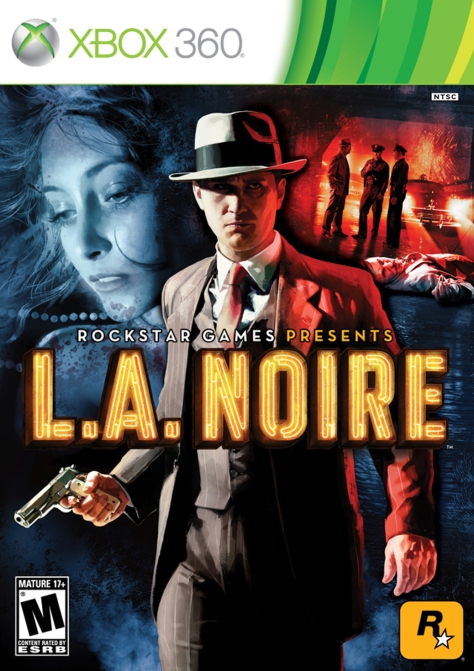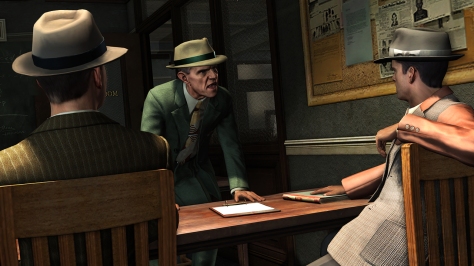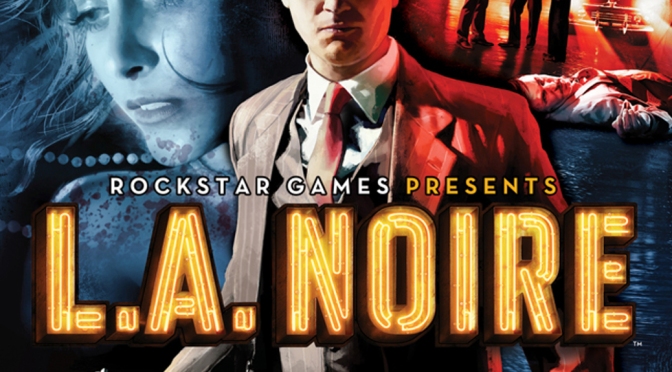
Growing up with video game magazines in the early 2000s, it always stuck out when writers would mention the film noir genre. It didn’t happen often since there weren’t many comparable video games, nonetheless when they did, it was universally positive. Whether referencing typical themes, character traits, or distinct audio/visual elements, the writers conveyed to me that films belonging to this genre oozed a classic cool. It took many years before I actually watched a noir film but once I did, I was sold. Accordingly, when I finally got around to playing L.A. Noire I fell head over heels.
Released for the Xbox 360 and PlayStation 3 on May 17, 2011 and for the PC later that year, L.A. Noire revolves around war veteran and rookie cop Cole Phelps. With the player in control, the narrative sees Cole quickly work his way up the ranks, solving cases across multiple bureaus of the police force, before suffering an equally prompt fall from grace. Cases mirrored real-life crimes while the overarching plot had many story beats in common with noir classics. Los Angeles, like everything else, was recreated with stunning detail and served as an open-world to roam about. Investigations and interrogations were the most emphasized gameplay features and the elements I found the most stimulating. The more action-focused bits were merely serviceable. Taking everything into consideration, L.A. Noire has become one of my favorite video games and is rightfully measured as an achievement for the medium.

The main story arc encompassed about two-dozen cases, tracking Cole’s rise and fall within the police department. Portrayed by Aaron Staton, Cole was dutifully upright, a shining example of the ideal policeman, and a pure avatar for the player. Flashbacks to his tenure in World War II divided chunks of the game, providing personal backstory and explaining a particular adversarial relationship. As he transitioned from bureau to bureau he worked alongside multiple partners whose ethics and politics differed, offering a greater look at the makeup of the police force. Two of his partners in particular were quite memorable.
Roy Earle and Herschel Biggs were Cole’s partners while working the Vice and Arson desks, respectively. Roy was smug, dirty, and looking to climb the ranks whereas Biggs was reaching retirement and hesitant to dole out trust or respect. Adam Harringotn and Keith Szarabajka, the actors portraying these characters imparted so much humanity, that when I google them and see the uncanny resemblance, the strong emotions I developed towards those characters begins to wash over me. I can do this with every character in the game to differing degrees and when I see them going forward, I’ll likely think “oh, they were in L.A. Noire.” A powerful statement for both the tech and the acting, I’d say.

The cases Cole was assigned were inspired by real-life crimes and films of the era, compiled here, they represented a “greatest hits” of the noir genre. For instance, the murder of Elizabeth Short, aka the Black Dahlia, and public/private collusion and corruption were two of the major threads that connected many cases. When driving around town, dispatch would buzz in alerting Cole and his partner to crimes in progress. Accepting these started brief sidequests that focused solely on action. With investigation missing, I didn’t find these compelling, until I needed to complete them for an achievement.
A lot of time was spent driving between destinations and in typical Rockstar fashion, storytelling and character building was maximized in these moments. When setting off for a new destination, Cole and his partner always had something to discuss. These conversations usually revolved around case details but they were utilized expertly to also flesh out the characters and allow for relationship growth. His partners were real charmers too: if I didn’t want to drive, they’d take the wheel and get us to our destination! According to most accounts, Los Angeles was recreated with a remarkable level of authenticity and detail, to which I’d concur. It was a massive open-world sandbox in the vein of Grand Theft Auto although it lacked the diversity of sidequests that series is known for.

While Cole’s partners could drive me around, I didn’t mind the task too much. Over one hundred varieties of automobiles were scattered throughout LA and as with most everything else, they were faithfully depicted. A few dozen popular period songs populated the airwaves while driving but it was Andrew and Simon Hale’s original score that set the mood in each scene. Heavily inspired by film noir soundtracks, their compositions could likely pass as arrangements. I mean this with the highest praise; I truly did enjoy the variety of their work and sought out the soundtrack after completing the game. A few original vocal tracks by The Real Tuesday Weld and Caludia Brücken, used to accentuate a jazzy lounge and a key character, were also present on the soundtrack and shine in their own right.
Although the cases varied depending on the bureau (homicide, vice, arson, etc.), the gameplay flow remained similar. After receiving orders, Cole and his bureau partner would begin their research, investigating crime scenes and interrogating key people before coming to a conclusion on who to charge. Clues and evidence came in multiple forms, found objects and interrogation observances to name a couple, and were used to build the case against a suspect. These were added to Cole’s notes and I was able to reference them at any point, even during conversations. It lent the feeling of an adventure game like Broken Sword, where I’d collect items to utilize at some later time.

Interrogations were especially impressive due to the lifelike facial reactions provided by the proprietary motion scanning technology Team Bondi implemented. In short, it was the most advanced utilized in a video game at the time, and may still be for all I know. Speaking with suspects and culprits, I chose dialogue options from a conversation tree, like one would do in a BioWare game. When his interviewee answered, I had the opportunity to take their statement at face value or call them on it, as long as I could produce a piece of contradictory evidence. The choice I made was based on my ability to “read” the subject, looking for the reveries that may insinuate a less than honest answer.
My ability to read those opposite Cole was actually quite poor, though it was of little consequence ultimately. I’d like to think my inaccuracy was due to me rushing through interviews and not devoting my full attention. There were many instances where I was iffy on which piece of evidence to select or who to charge, but playing through a second time with a guide, I can’t recall missing evidence or having to make an arbitrary choice. It was all down to me to think critically and apply my own detective skills. As I mentioned though, wrong choices didn’t matter too much. The overarching story was rigid and linear, allowing for minimal and inconsequential variations throughout.

Regardless of the desk Cole was working from, cases almost always required him to get his hands dirty. Car chases, fisticuffs, and shootouts were a reality of his job and added an action element to the game. Gunplay was the most common method of dealing with troublesome individuals and it frequently meant participating in large-scale shootouts. Taking cues from Gears of War and basically every other third-person shooter of the period, use of cover was important. It was not crucial though, as foes gave me plenty of time to line up headshots. Cole’s maneuverability and responsiveness to my inputs was somewhat stiff, perhaps more realistic compared to the game’s peers. While this sort of thing usually turns me off, I was a little more understanding considering the level of authenticity that permeated throughout.
When given the option, I refrained from fisticuffs, opting instead to handle gangsters and thugs at a safer distance with a firearm. Infrequently, I’d be forced to handle a foe mano a mano. As this was a rare occurrence, I failed to learn the controls, not that it mattered. The fights ended quickly, often with a satisfying final blow. Much more frequent were the car chases. They littered seemingly every story mission and were populous amongst the many sidequests, too. It didn’t take long for me to tire of them. Tasked with crippling an escaping vehicle I could hardly keep up with, I regularly succeeded by “playing out” the chase. Eventually, everyone I chased wrecked of their own ineptitude, at which point Cole could make his arrest.

Unfortunately, Team Bondi became embroiled in controversy and shuttered not too long after the release of L.A. Noire. What we’re left with though, is one of the finest narratively-driven video games one can play, even taking the passable action gameplay into consideration. It’s enriched by thrilling stories and well developed and realized characters. Further, participating in the investigations and interrogations was a video game highpoint, buoyed by the remarkable technology and craftsmanship applied to the characters. This technical craftsmanship was evident in every aspect of the game; no detail was too small. Everything coalesced into an experience that I was more than happy to dive back into after my first completion. For me, that’s the highest praise I can extend to a narratively-driven video game. In short, L.A. Noire needs to be on everyone’s must-play list.

Great write-up! How long roughly did it take you to play through? I’ve had the game sitting unopened for years in my backlog. Tempting me but always just slightly put off by feeling like it would need a huge time investment along with a sour taste left by the douchey machinations and behaviour of McNamara.
LikeLiked by 1 person
My initial playthrough took about twenty hours, completing about a third of the sidequests along the way.
I forgot about the negativity surrounding the environment at Team Bondi until doing some research for this review. Telling, that he hasn’t worked on a published game since this one.
Regardless, playing through this game has sparked an interest to play The Getaway, the other game he wrote and directed.
LikeLike
Thanks. I might wait until I’ve got some free time in a decent chunk to go through LAN. I tend to try and do all of the sidequests and only give up on the most tedious of the busywork (collecting foozles, etc). Agreed that McNamara hasn’t seen the light of day for many years now – and probably a good thing. I tried to play The Getaway back when it was current. Great graphics, but I found the gameplay was unfortunately too much of a barrier to put much time in, so it went away. At least LAN got way past that issue. 🙂
LikeLiked by 1 person